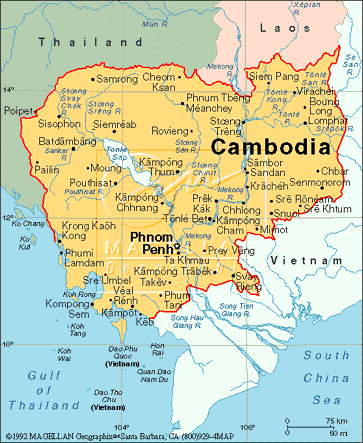|
The center
of the legendary Angkor Empire was situated on the territory of today's
Cambodia. The empire reached its golden age in the period between the 9th
and 15th centuries, when the world-famous temple-pyramids, ornamental sanctuaries,
water basins and reservoirs, unique canal network, road system and dam
system were built.
The wealth of Angkor was due to the huge empire’s many conquests of significant territories in today's Thailand, Malaysia, Laos and Vietnam. These conquests, however, later also caused the empire’s fall, because its wealth constituted an attractive target for the neighboring empires. The chams, the feared enemies of the flourishing Angkor who devastated it in the 12th century and whose figures often appear in the reliefs on Khmer temples, lost their once enormous empire (situated in the middle of today's Vietnam) by the end of the 15th century. Their place was taken by new conquerors: the Siamese Ayutthaya in the west, the new Lao confederation, the Lan Sang in the north, and Dai Viet in the east. The new empires conquered more and more territory of the weakening Khmer Kingdom, and eventually occupation became inevitable: Angkor fell under Siamese authority for the next few centuries. Until the end of the 19th century, the Cambodian monarchs were brought up in Bangkok, and apart from them only the representative of the Siamese King had from time to time greater influence on state affairs in the Khmer royal court. The acceptance of a French protectorate in the second half of the 19th century brought an end to both Siamese and Vietnamese influence. Cambodia became fully independent in 1954, but after the decade-long reign of Prince Norodom Sihanouk, the country became involved in the Indochinese war. After the war, military dictatorship was introduced, which in its turn was followed by years of destructive civil war. In 1975 the infamous Khmer Rouge led by Pol Pot took control. During only four years of their regime of terror, which is considered one of the bloodiest dictatorships of the 20th century, a quarter of the country’s ten million inhabitants became victims of famine, torture and deportations. The period of bloody civil war ended in 1993, and the, after elections organized by the UN, fragile coalition governments followed one another, and a limited monarchy was instituted. Today Cambodia is the 10th member of
the Association of Southeast Asian Nations (ASEAN).
Phnom Penh Cambodia's present capital, Phnom Penh, replaced the deserted Angkor as the center of the Khmer Kingdom in the 15th century. Situated where Tonle Sap flows to the Mekong River, the city once had been considered one of the “pearls” of the French Indochinese colonies. Phnom Penh and its surroundings are today rich in monuments from both the colonial and the Khmer royal periods, although Pol Pot and his Khmer Rouge did nothing for the survival of these monuments. They blamed Western civilization for their people's suffering and attempted to restore the Angkor Empire by deporting the population of the capital into provincial forced-labor camps, blowing up the banks, suspending the use of money, praising the peasants’ work, and fully liquidating the intelligentsia and the clergy. Phnom Penh became a ghost city with roughly 80,000 inhabitants remaining out of two million. Today Phnom Penh is again a flourishing administrative and governmental center, but its population still does not exceed 800,000. |

Map courtesy of Magellan Corp. Please click on the animated rectangle
to go to the next section.
|